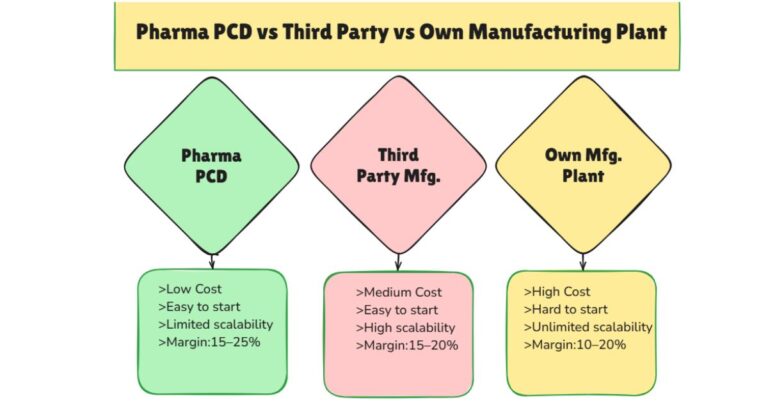Working and Principle of tablet compression machine
Tablets in medicinal forms are the most used drug dosage form of any medicine. Tablets look very beautiful and available in different shapes but their manufacturing process is very weird as compared to what the common person thinks. The compression of uniform and nonuniform granules between dye and punches creates the miracles of making different-sized tablets. Innovations in the pharma industry make it possible to manufacture lakhs of tablets per hour on one machine. In this conceptual article, you will be able to know about the Working and Principle of tablet compression machines.

Principle of tablet compression machine
The tablet compression machine works on the principle of hydraulic pressure. The hydraulic pressure is converted into the static fluid and pressure is applied on static fluid from all directions resulting a tablet of granules or powder. The force from the lower die and upper punch allows granules to take a shape and strength.
Types of compression machines?
Usually, there are two major types of compression machines: a) Single Station machine, b) Multi-Station machine.
These days lots of variety are found in multi-station machines like 24 station rotary, 27 station, 37 station, 45 station, and 55 station rotary machines.
Various stages of the Compression Process:
There are almost four major stages in the compression process of tablets that are illustrated below:
i) Filling:
During this procedure of the tablet compression machine, the granules are moved into position for tablet compression. After that, the final product is combined with the homogeneous blend. After that, the mixture flows into the punch-die cavity of the compressing tool.
Punch-die and lower punch are used to make the punch-die cavity. The volume of the cavity is then determined by the position of the lower punch in the die. This volume must be adjusted to account for the weight of the granules that will be compressed to make the tablets.
ii) Metering:
In this stage of compression of tablets, the excess material of granules is ejected out from the dye punch section of the machine. The metering cam adjusts the required volume of tablet that is set by the operator as per requisition.
In this technique, the main role of the lower punch is allotted that move upward in such a way so that the excessive powder than the required is thrown out and the desired weight tablet can be manufactured.
iii) Compression:
Compression is the main stage of this whole process. In this process, the lower (die) and upper punch come together to form the tablet with the help of pressure from the topside. The resultant of two punches coming together produces a tablet.
Other important parameters like hardness and the thickness of the tablet depend on various factors that happened during compression. The distance between punches and the pressure applied are the main two factors that decide the thickness of the tablet and the hardness of the tablet.
iv) Ejection:
The upper punch retracts from the die cavity and rises above the turret table. Simultaneously the lower punch rises upward and thrusts the tablet upward in the die that helps it come out of the die. The ejection stage is ejecting the tablet from the die punch station mechanically with a continuous process. A different container or basket is placed bottom side at a safe height to collect tablets.
Tablets compression machine parts
Tablets compression machine parts are given here:
- Feeder System
- Tablet Press Punches
- Tablet Press Die System
- Tablet Press Turret
- Tablet Press Machine Cam Tracks
- Tablet Press Filling Station & Weight Control
- Compression Rollers
- Tablet Press Ejection Cam
- Take –off blade and Discharge Chute
- Other Tablet Compression Machine Parts
Critical parameters of tablet compression machine:
Critical parameters of tablet compression machine are characterized in following four main functions:
Turret Speed (Two level):
Turret speed ranges between 14 and 25 RPM, and it provides a hardness effect in tablets, a desired response is 18+ 3 kP.
Pre-compression Force:
Precompression force should be between 1.9 and 2.9 KN. It affects the friability of tablets. An accepted limit for friability is preferred NMT 0.5%.
Main Compression force:
The main compression force is the maximum force applied during the manufacture of a tablet. The force ranges between 5.3 and 9.0 KN. It puts its effect on the disintegration time of tablets, the optimum DT time should not be more than 500 seconds in general situations.
Feeder speed:
Feeder speed is a motion at the rate the granules fill in the cavity of the die and punch. The feeder speed should be between 18 to 30 RPM, It impacts the thickness of tablets.
FREQUENTLY ASKED QUESTIONS:
Q-How does compression force affect tablets?
ANS-Compression force is a necessary parameter for tablet compression, excessive force can lead to over-hardness of tablet Otherside lower force can leave a tablet with high friability or brokerage rate. There is a calculated or stipulated amount of force required to manufacture tablets with the best results.
Q-Why do we compress tablets?
ANS-Compression is a well-developed method to manufacture tablets that provides a good degree of hardness, better uniformity of content, better uniformity of weight and size of the tablet. Compression also allows us to handle tablets at various stages like coating and blistering so that to have a certain level of hardness.
Q-What is the limit of friability?
ANS-The Friability limit of tablets is NMT 1%.


